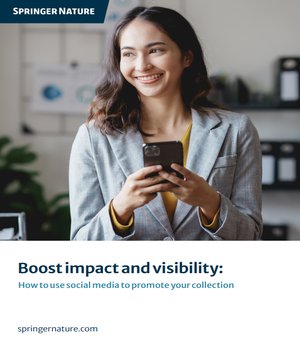How to promote Collections on social media: Tips for guest editors
If you’re a guest editor leading a Ïã¸ÛÁùºÏ²Ê¹ÙÍø Collection, your role goes beyond curating high-quality research—it’s also about ensuring that the Collection reaches the right audience and has the impact it deserves. With more researchers than ever turning to social media for scholarly discovery, promoting your Collection online can be one of the most effective ways to boost submissions, readership, and engagement.
That’s why Ïã¸ÛÁùºÏ²Ê¹ÙÍø has launched a practical, step-by-step guide:
This guide is specifically designed for guest editors like you. Whether you're already active on social platforms or just starting out, it offers easy-to-follow strategies for using social media to promote your Collection before, during, and after launch.
Why social media matters
The guide opens with a powerful insight: social media is simply an extension of academic networking. Just as you might invite contributors through conference conversations or email outreach, platforms like LinkedIn, Bluesky, and WeChat offer real-time ways to engage with researchers you know—and many you don’t.
According to the , 75% of active researchers use social media for professional purposes, and over 80% use it to search for new research content. That makes these platforms one of the most valuable tools available for guest editors who want to attract contributors and spark discussion around their Collections.

What the guide covers
This resource walks you through each stage of your Collection’s promotion lifecycle, including:
Before publication: Recruiting contributors
Use short, eye-catching posts to explain your Collection’s theme and invite submissions. Highlight what makes the topic timely or impactful. Tagging relevant colleagues or influencers and using hashtags related to your field can boost visibility and engagement.
During publication: Sharing new content
If your Collection publishes articles on a rolling basis, promote each one as it goes live. The guide suggests spotlighting standout research, tagging authors (with their permission), and explaining why each article matters.
After publication: Sustaining momentum
The work doesn’t stop once the last paper is published. Continue posting about key findings or quoting authors. The guide encourages sharing infographics, charts, or visuals from the articles to catch attention and drive engagement.
Choosing the right platform
One of the guide’s most helpful sections is its platform-by-platform breakdown. It outlines how to use:
- LinkedIn for professional engagement and visual posts
- X/Twitter for real-time conversation and tagging researchers
- Instagram and Stories for visuals and links via bio
- WeChat for targeted promotion in China
- Bluesky, a newer platform with academic communities
- Facebook for groups and institutional pages
It also offers practical instructions for posting on each platform, including adding links, tagging accounts, and choosing the best images and hashtags.
Quick tips for effective promotion
The guide is filled with actionable advice, such as:
- Start with one platform: Don’t feel pressured to be everywhere. Focus where your research community is most active.
- Collaborate: Divide social media tasks with your co-editors to keep things manageable.
- Post consistently: Use a simple schedule or checklist to maintain momentum.
- Use visuals: Posts with images get significantly more engagement.
- Tag and thank contributors: A personal touch goes a long way in building community.
Everything you need to master social media promotion
Whether you’re promoting a call for papers, a newly published article, or the full Collection, this guide gives you all the tools you need to make social media work for your goals as a guest editor.



